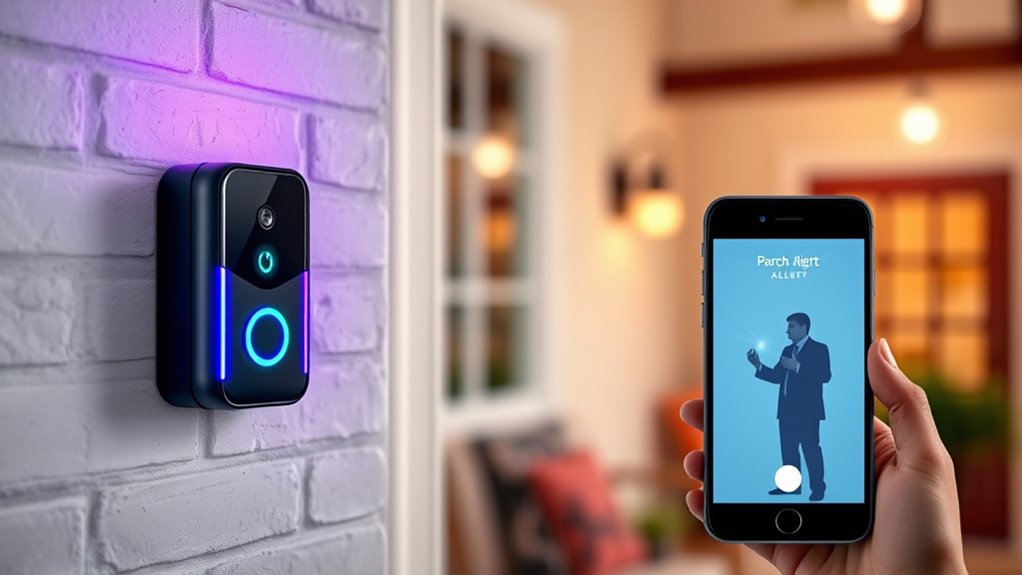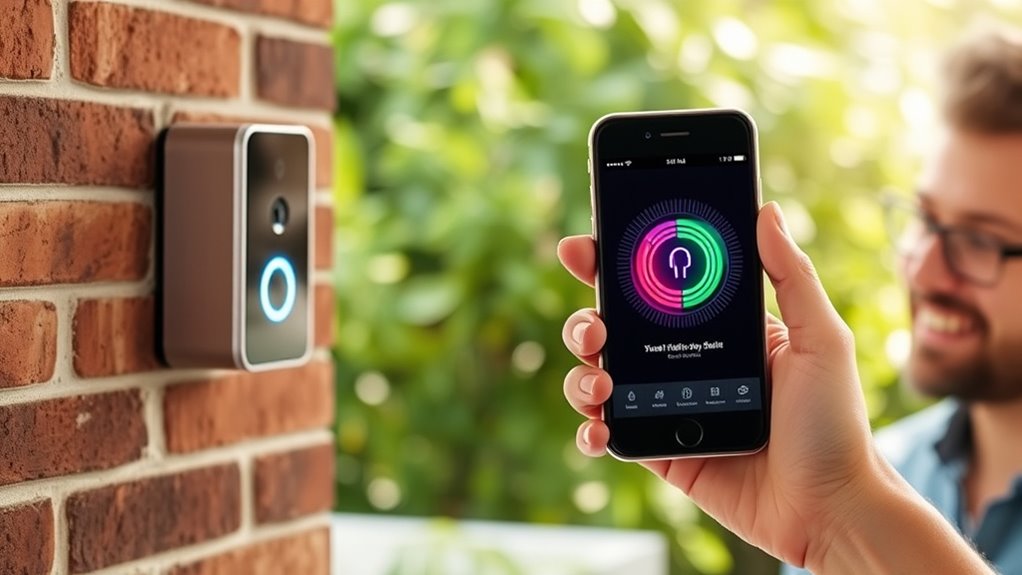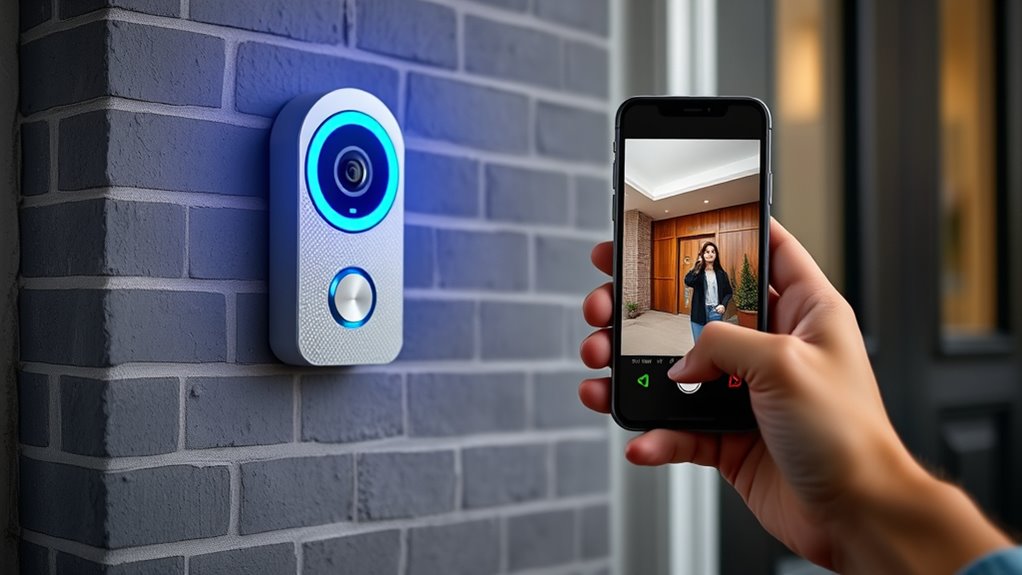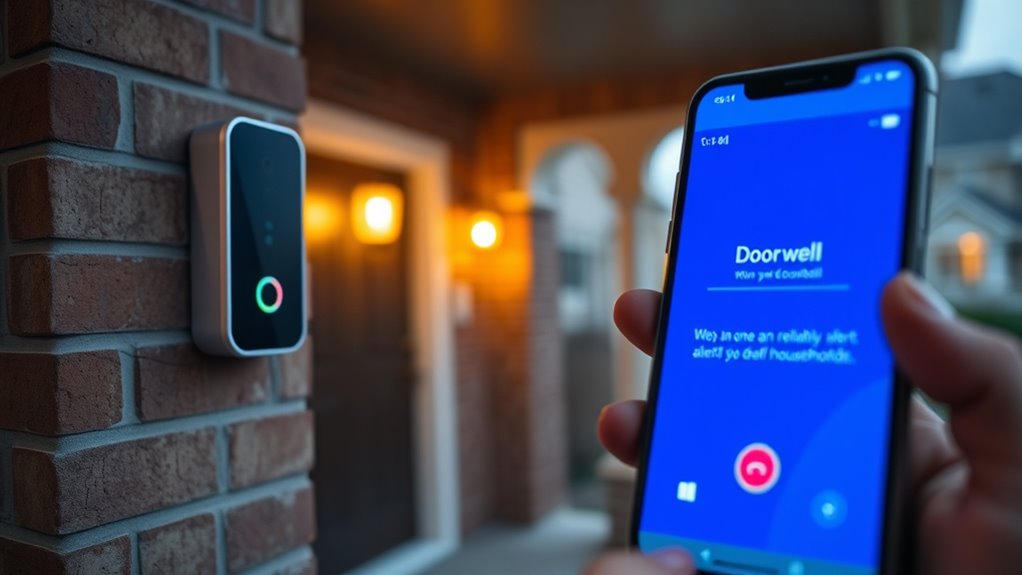Smart doorbells paired with phone alerts guarantee you never miss a visitor or important notification. Features like visual cues, flashing lights, and vibrations help alert you instantly, even without hearing. Easy setup and compatibility with your smartphone make integration seamless. Reliable Wi-Fi connections and customizable alerts keep you updated in real-time. Want to discover the best options and tips to stay connected? Keep exploring to find solutions that fit your needs perfectly.
Key Takeaways
- Visual alert systems with flashing lights and screens ensure deaf residents notice visitors instantly.
- Seamless smartphone notifications via apps enable real-time alerts when visitors arrive.
- Compatibility with smart home hubs and wireless protocols allows easy integration and customization.
- High-resolution video with night vision and clear audio enhances visitor identification and security.
- Reliable system setup, including stable Wi-Fi and regular updates, prevents missed notifications.
How Smart Doorbells Enhance Home Security for Deaf Residents

Smart doorbells substantially improve home security for deaf residents by providing immediate, visual alerts when someone is at the door. These devices often integrate with interior lighting systems, flashing lights or screens to catch your attention instantly. This guarantees you won’t miss a visitor or potential threat, even if you’re not looking directly at the door. Additionally, many smart doorbells allow you to set up emergency contacts, so alerts can be forwarded to family members or security services if needed. This layered approach enhances safety by combining visual cues with quick communication options. With smart doorbells, you gain a reliable, accessible way to stay aware of your surroundings and respond promptly, giving you peace of mind and greater control over your home security. The integration of projector technology in alert systems can further personalize notification methods, making them even more effective for deaf households. Incorporating visual alert systems ensures that all residents, regardless of hearing ability, are promptly informed of visitors or emergencies. Utilizing network connectivity enables seamless updates and real-time alerts, further enhancing safety features. Moreover, implementing customizable alert options allows users to tailor notifications to their specific needs and preferences, increasing overall effectiveness.
Key Features to Look for in a Deaf-Friendly Doorbell System

When choosing a doorbell system for a deaf household, it’s important to focus on features that guarantee you won’t miss visitors or alerts. First, look for a system with a clear visual design, such as bright LEDs or flashing lights, to ensure visibility. Second, consider the installation process—choose models that are easy to set up without complex wiring or tools. Third, verify compatibility with your existing smart home devices for seamless integration. Fourth, opt for customizable alert options, like adjustable light patterns or sounds, to suit your preferences. Prioritizing these features helps create a reliable, user-friendly system that effectively signals visitors and enhances your home’s accessibility and security. Additionally, exploring best animated movies can provide emotional comfort and entertainment for all household members during quiet moments. Ensuring the system has reliable notification methods, such as visual alerts or vibrations, guarantees consistent alerts, which is crucial for safety and peace of mind. Incorporating clear visual cues can further improve communication, especially in dynamic household environments. Moreover, choosing systems that utilize vegetable juices in their energy-efficient components can contribute to sustainability and lower operational costs. Also, selecting systems that comply with privacy policies ensures your household data remains protected while maintaining effective alert features.
Setting up and Integrating Phone Alerts With Your Doorbell

To effectively set up and integrate phone alerts with your doorbell, start by downloading the compatible app recommended by the manufacturer. Next, verify your doorbell wiring is properly connected during outdoor installation to enable reliable power and connectivity. Once installed, open the app and follow the setup instructions to link your doorbell to your smartphone. This typically involves creating an account and syncing your device via Wi-Fi. Make sure your doorbell is within range of your network to prevent interruptions. After setup, customize your alert preferences, such as push notifications or sound alerts, so you’ll be notified immediately when someone rings the bell. Proper outdoor installation and wiring are vital for seamless communication between your doorbell and phone alerts. Ensuring your doorbell’s power connection is stable helps maintain consistent alerts and prevents false notifications. Additionally, maintaining a reliable Wi-Fi connection ensures your notifications are timely and accurate. Regularly updating your software and firmware can also improve the stability and security of your notification system. Implementing efficient troubleshooting practices, such as checking for interference or signal obstructions, can help identify and resolve connectivity issues early on. Incorporating remote work best practices, such as testing your alerts during different times of day, can help identify any connectivity issues early on.
Comparing Popular Smart Doorbell Models and Their Capabilities

When choosing a smart doorbell, you’ll want to compare video quality, alert options, and how well each model connects with your existing devices. Consider how clear the video streams are, whether you can customize notifications, and if the doorbell easily integrates with your home setup. These features help make sure you get a model that best suits your needs and enhances your home security. Additionally, reviewing the operating hours of nearby stores can help you plan when to purchase or seek support if needed. To ensure optimal performance, pay attention to the connectivity options and compatibility with your smart home ecosystem. Understanding the privacy and security features offered by each device is also important to protect your personal data and maintain your household’s privacy. Moreover, evaluating the ease of installation can save you time and help you get your system up and running smoothly. Familiarizing yourself with ethical hacking principles can also help you identify potential vulnerabilities in your smart home devices and safeguard your privacy.
Video Quality and Clarity
Compared to earlier models, modern smart doorbells deliver markedly sharper and clearer video footage, making it easier for deaf households to identify visitors. High video resolution ensures crisp images, even in low-light conditions, enhancing overall visibility. When evaluating models, consider these factors:
- Video resolution – Look for 1080p or higher for detailed visuals.
- Audio clarity – Clear, noise-free audio helps you understand visitors’ messages without distortion.
- Night vision capabilities – Infrared features provide visibility in darkness.
- Frame rate – Higher frame rates deliver smoother video, capturing more accurate visitor movements.
- Self Watering Plant Pots – Incorporating smart technology into self-watering planters can help busy households maintain healthy plants with less effort, showcasing how innovative features extend beyond security devices. Additionally, integrating accessible alert systems can ensure that deaf users receive prompt notifications through visual cues or vibrations, further enhancing safety and communication. Ensuring that the video compression used in smart doorbells minimizes lag and preserves image quality also contributes to a more reliable monitoring experience. Properly optimized video compression can also reduce bandwidth usage, making the system more efficient and suitable for various internet speeds. Choosing a model with superior video resolution and audio clarity guarantees you won’t miss important details, ensuring your safety and peace of mind.
Alert Customization Options
Many smart doorbells now offer extensive alert customization options, allowing you to tailor notifications to your specific needs. You can choose from various personalization options, such as setting different alert modes for visitors or packages. Alert sound customization is also common, enabling you to select specific chimes or tones that grab your attention effectively. Some models let you create custom alerts based on motion detection sensitivity or visitor recognition, reducing false alarms. These features ensure you’re promptly notified in ways that suit your preferences, whether through unique sounds, visual indicators, or combined alerts. Additionally, understanding the Personality Traits of users can help optimize alert settings for better responsiveness and personal comfort. Proper User Consent Management ensures you can customize your notification preferences without compromising privacy, which is crucial for sensitive households. Awareness of security features can help you select models that offer enhanced protection for your household’s privacy. Implementing efficient general ledger coding can also help manage your household’s connected devices and subscriptions more effectively, ensuring seamless operation. By exploring the alert customization options of popular models, you can design a notification system that keeps you informed without overwhelming you, making your smart doorbell truly work for your household’s needs.
Compatibility and Connectivity
Choosing a smart doorbell that seamlessly integrates with your existing devices depends heavily on its compatibility and connectivity features. You want reliable device interoperability and support for common wireless protocols to guarantee smooth operation. Key aspects include:
- Compatibility with your smartphone’s operating system (iOS or Android)
- Support for wireless protocols like Wi-Fi, Zigbee, or Z-Wave for robust connectivity
- Ability to connect with smart home hubs or assistants such as Alexa, Google Assistant, or Apple HomeKit
- Stable, secure connections to prevent dropouts and maintain real-time alerts
Assessing these features helps you pick a model that works well within your current setup, ensuring you receive prompt, dependable alerts without compatibility issues.
Tips for Ensuring Reliable Notifications and Avoiding Missed Alerts

To make certain you don’t miss any alerts, keep your device’s connection stable and strong. Adjust notification settings so they’re loud and clear for your needs. Regularly check these settings to ensure everything works smoothly.
Maintain Device Connectivity
Ensuring your smart doorbell stays connected is essential for receiving timely alerts. Reliable Wi Fi stability and proper device synchronization prevent missed knocks. To maintain connectivity:
- Check your Wi Fi signal strength regularly and upgrade your router if needed.
- Keep your firmware and app updated to enhance device synchronization.
- Position your router centrally to reduce dead zones around the doorbell.
- Use a dedicated network or VLAN for your smart devices to minimize interference.
Customize Notification Settings
Adjusting your notification settings is key to making sure you never miss an alert from your smart doorbell. After doorbell installation, explore the user interface customization options to tailor alerts to your needs. Many smart doorbell apps let you set preferred notification types, such as visual alerts or vibrations, ensuring you’re aware of visitors even if you’re not near your phone. Adjust volume levels, enable or disable specific alerts, and customize alert timing to avoid missing important visitors. Some apps also let you assign different notifications for different visitors or activities. Take time to test your settings, so you’re confident you’ll get reliable alerts every time someone knocks or triggers your doorbell. Proper customization helps you stay connected and responsive, no matter your household’s communication needs.
Real-Life Stories: Transforming Home Safety Through Technology

Many deaf homeowners have found that smart doorbells dramatically improve their safety and peace of mind. These devices, integrated into smart home automation, allow you to see and hear visitors through visual alerts and connected apps. Real-life stories reveal how this technology transforms daily living:
- Enhanced security, with instant notifications on smartphones or smart displays.
- Quick responses enabled by virtual assistance that can announce visitors or alert family members.
- Increased independence, as you no longer need to rely on others to check who’s at the door.
- Seamless integration with other smart devices, creating a exhaustive safety system.
Future Innovations in Accessibility and Smart Home Security

As technology continues to evolve, future innovations in accessibility and smart home security promise to make homes safer and more inclusive for everyone. Augmented reality (AR) could overlay visual alerts directly onto your environment, showing who’s at the door or alerting you to activity. Voice-controlled interfaces will become more sophisticated, allowing you to operate doorbells, cameras, and security systems effortlessly. Imagine asking your smart device, “Who’s at the door?” and receiving instant visual and auditory feedback. These advancements will integrate seamlessly into daily life, ensuring deaf households stay connected and protected. Here’s a glimpse of upcoming innovations:
| Innovation | Benefit |
|---|---|
| AR alerts | Visual notifications overlay |
| Voice control | Hands-free system operation |
| AI recognition | Smarter visitor identification |
| Haptic feedback | Vibrations for alerts |
| Integrated sensors | Enhanced detection and response |
Frequently Asked Questions
Are Smart Doorbells Compatible With All Types of Smartphones?
Smart doorbells vary in smartphone compatibility, so you should check the doorbell app requirements before purchasing. Most are compatible with both iOS and Android devices, but some might have specific version needs. To guarantee seamless operation, verify your phone’s OS and the app’s compatibility. This way, you can enjoy real-time alerts and video access, no matter what type of smartphone you use.
Can Deaf Households Customize Alert Sounds or Vibrations?
You can definitely customize alert sounds and vibrations on your smart doorbell. Most devices offer customizable alert options, allowing you to choose specific sounds or set vibration feedback settings that suit your preferences. You have control over how you’re notified, whether through different tones or vibrations, ensuring you won’t miss visitors. This flexibility helps create a tailored experience, making sure alerts are effective and accessible for deaf households.
What Is the Typical Cost Range for Deaf-Friendly Doorbell Systems?
Considering costs, common deaf-friendly doorbell systems typically cost between $50 and $200, depending on features. You’ll want to factor in installation costs, which can range from free to around $50, and any subscription fees for advanced notifications or app access. While simple models offer basic alerts, more sophisticated systems provide visual or vibrating signals, making it easier for you to notice visitors without missing a knock.
How Do Smart Doorbells Handle Power Outages or Internet Disruptions?
When power outages or internet disruptions happen, smart doorbells with backup power guarantee you don’t miss visitors. They switch to a local power source or battery backup, keeping alerts functional. Offline alerts activate when connectivity drops, so you still receive notifications via your phone or device. This way, you stay informed even during disruptions, maintaining seamless communication and security for your household.
Are There Privacy Concerns Associated With Smart Doorbell Video Recordings?
You might worry about privacy concerns with smart doorbells, especially regarding video storage and surveillance privacy. These devices record footage that’s often stored in the cloud, raising fears about unauthorized access or data breaches. Always check the privacy policies and security features, like encryption and user controls, to safeguard your footage. By understanding how your video recordings are managed, you can ensure your home’s surveillance privacy stays intact.
Conclusion
Embracing smart doorbells transforms your home into a fortress where deaf households stay connected and safe, like a lighthouse guiding ships through darkness. By choosing the right system and ensuring reliable alerts, you turn technology into an unbreakable bridge that keeps you aware of every knock. With continuous innovations on the horizon, you’re not just keeping up—you’re shaping a future where accessibility and security shine together, illuminating the way for all.











